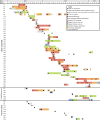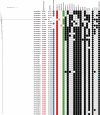Simultaneous Hospital Outbreaks of New Delhi Metallo-β-Lactamase-Producing Enterobacterales Unraveled Using Whole-Genome Sequencing
- PMID: 35311539
- PMCID: PMC9045244
- DOI: 10.1128/spectrum.02287-21
Simultaneous Hospital Outbreaks of New Delhi Metallo-β-Lactamase-Producing Enterobacterales Unraveled Using Whole-Genome Sequencing
Abstract
Multidrug-resistant Enterobacterales, including carbapenemase producers, are currently spreading in health care facilities and the community. The Bichat Claude Bernard hospital in Paris faced a prolonged NDM-producing Enterobacterales (NDM-CPE) outbreak. Whole-genome sequencing (WGS) was performed on all isolated NDM-CPE to evaluate its benefits for outbreak surveillance and comprehension. All NDM-CPE isolates collected during the outbreak period (August 2016 to January 2018) were sequenced using the Illumina NextSeq platform. Gene content and core genomes were compared. Genomics results underwent epidemiological analysis which classified NDM-CPE cases as imported (positive sample during the 48 h after admission), hospital acquired, or uncertain. Over the epidemic period, 61 patients were colonized or infected with 81 distinct NDM-CPE isolates. Klebsiella pneumoniae was the most common species (n = 52, 64%), followed by Escherichia coli (13.5%) and other species (22.5%). In all, 43/52 (83%) K. pneumoniae isolates were clonal (≤18 single nucleotide polymorphisms [SNPs] except for three isolates) and belonged to ST307. The IncFIIK [K2:A-/B-] plasmid carrying blaNDM-1 present in all ST307 K. pneumoniae isolates was also detected in 18 other NDM-CPE isolates. Additionally, eight clonal ST144 Klebsiella oxytoca (≤18 SNPs) isolates lacking the epidemic plasmid were observed. The WGS analyses confirmed the acquired and imported cases except for two patients and resolved uncertain cases, which all turned out to be hospital acquisitions. WGS coupled with epidemiological analysis unraveled three epidemic phenomena: mainly the spread of a clonal ST307 K. pneumoniae strain and its conjugative plasmid carrying blaNDM-1 but also the unexpected clonal spread of an ST144 K. oxytoca strain. IMPORTANCE Carbapenemase-producing Enterobacterales (CPE) can spread and cause outbreaks in health care facilities, resulting in increased lengths of stay and morbidity. Control of outbreaks requires epidemiological surveillance, usually based on microbiological screening and patient follow-up. These data are sometimes insufficient to identify the routes of dissemination. There is therefore a need for more accurate tools such as whole-genome sequencing (WGS), which allows comparison of isolates but also plasmids carrying resistance with a high definition. In this work, we retrospectively sequenced the genomes of all NDM-producing Enterobacterales isolated during a prolonged NDM outbreak in our hospital. We demonstrated the value of combining WGS with epidemiological data that unveiled the multiple mechanisms of dissemination involved in the outbreak and confirmed transmission cases. This work reinforces the potential of WGS in outbreak surveillance and suggests that it could improve outbreak control if used in real time by confirming transmission cases more rapidly.
Keywords: Klebsiella oxytoca; Klebsiella pneumoniae; NDM; carbapenemase-producing Enterobacterales; outbreak; whole-genome sequencing.
Conflict of interest statement
The authors declare no conflict of interest.
Figures





References
-
- European Centre for Disease Prevention and Control. 2020. Antimicrobial resistance in the EU/EEA (EARS-Net) - annual epidemiological report for 2019. European Centre for Disease Prevention and Control, Solna, Sweden. https://www.ecdc.europa.eu/en/publications-data/surveillance-antimicrobi....
-
- Haut Conseil de la Santé Publique. 2019. Actualisation des recommandations relatives aux BHRe Rapport de l’HCSP. Haut Conseil de la Santé Publique, Paris, France. https://www.hcsp.fr/explore.cgi/avisrapportsdomaine?clefr=758.
-
- Carbonne A, Thiolet JM, Fournier S, Fortineau N, Kassis-Chikhani N, Boytchev I, Aggoune M, Séguier JC, Sénéchal H, Tavolacci MP, Coignard B, Astagneau P, Jarlier V. 2010. Control of a multi-hospital outbreak of KPC-producing Klebsiella pneumoniae type 2 in France, September to October 2009. Euro Surveill 15:19734. doi:10.2807/ese.15.48.19734-en. - DOI - PubMed
MeSH terms
Substances
LinkOut - more resources
Full Text Sources
Research Materials
Miscellaneous

